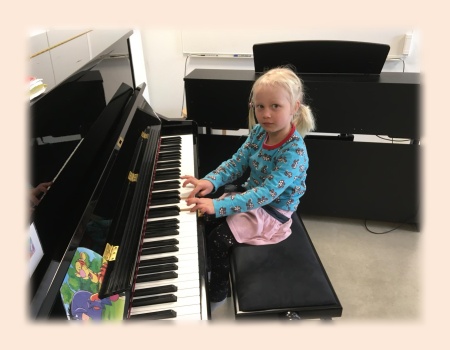|
In Nalle music school children from 4 to 7 years of age study by the nalle method, developed by Irma Wahlbeck. Children will learn to understand notes from the beginning, and play with improvisation. Students will also compose their own small pieces. This gives great joy and happiness to them.
Irma Wahlbeck developed Nalle method, , because she wants to teach children to play piano before the school age. She didn't find any satisfactory learning material, and so she started developing and researching for her own method. Nalle book by Wahlbeck is meant to be an appetizer, after which usually follow the books that are meant to children 7-8 years of age. The book relates in modern children's world of experiences. Old books about playing piano are often based in introduction of art music, which can be a little unfamiliar to modern children. The musical development of the child is carefully considered in nalle method and it will set the conditions for the studies.
Nalle Method: Plan of studies
The learning objectives are:
- To pay attention in sitting position and the position of hands
-
Acknowledging right and left hand
-
Counting from one to five
-
Recognizing musical alphabet
-
G and F -keys
-
Different values of notes
-
Tempo: fast and slow
-
Finger practices
-
One note at the time c-C2
-
Different musical symbols
-
Composing
-
Different playing techniques
-
Different styles: lullaby, march, etc.
-
Adding emotional expression
-
Active listening of music
Nalle method is a creative teaching method, that is developed for teaching instruments to children from 2 to 7 years of age. It is based on certain facts and research conclusions. It is a potpourri of many good teaching methods.
Instructions of the method
The book is divided in parts that train different aspects of playing, as reading sheet music, rhythm, motor skills and listening. All the musical pieces are played using both hands simultaneously; even we don't see the F-key notes all the time. I have chosen this way because the little pianists have such a tremendous amount of details to think as: letters, notes, rhythms, different symbols, and of course the motor skills, that aren't yet very developed. They combine visual and auditive perception with motor skills. What a performance!
The method works best when the child, parents and teacher work together. Parents have the great advance and responsibility to train their child DAILY with the musical symbols, notes and the homework's. All this requires enthusiasm, willingness and time.
Parents have to learn the meaning of the symbols first, to be able to help their children. Imitation is a very good tool. You can play the musical piece first to the child, to talk about its contents. Explaining difficult things simply and with enthusiasm, helps the child to bravely receive new information.
It is very important to practice daily, one or two times in about 5 to 10 minutes intervals. The notes, finger practices and musical pieces will be practiced.
All this should be learned as a child's game. Make learning a lot of fun! It's very important to respect the child. Children love learning new things.
Try to do the practices when your child is in a good mood. Sometimes practicing piano pieces may feel hard, but try to find a positive, relaxed and playful way to do them.
Check that there aren't any things that would weaken the concentracion: for example radio, music, TV or computer. Make learning and playing music a pleasure! Try to be enthusiastic and calm.
Balance is required from all: the student, the parents and the teacher. Motivation is the way to success. Be purposeful when you teach. After all, we want to help the child in his/her aesthetic education, not to ruin it.
We use symbol cards that are shown to the child. The cards should be shown every day to the child.
Psychologist Glenn Domain's tips to use the symbol card method:
- try to show the symbol cards in a very fast sequence that helps to keep your child's concentration and interest in high level.
-
When you have finished the homework, tell your child how gifted she/he is. Never bribe the child with candy or something similar, instead use love.
-
Do not test your child's abilities (that is the opposite of learning, full of stress, and does not lead to improvement)
-
Make learning new things enjoyable. All the learning periods should be moments filled with joy, peace and love.
-
It's a great gift to be able to teach one's child
-
Be enthusiastic
-
Children love to learn new things, but it has to be fast.
-
Practice daily, short 5-10 minutes sessions 2-3 times a day.
Nalle method may not be suitable to all families or musical institutions because its creativity. Some people want to conserve the traditional method. Luckily everybody has the opportunity to choose their own method and place to learn.
Improvisation, creativity, freedom, enjoyment, individual needs are the keywords of nalle method.
Children enjoy learning and creativity. The parents have a great advantage to conserve the practicing situations as wonderful moments in their life.

| 